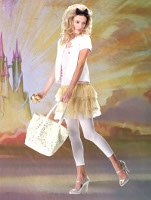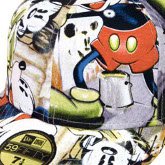Mickey Mouse Gets Fashionable, Goes Street
Mickey Mouse turned 80 on Nov. 18, the anniversary of the 1928 release of the pop-culture icon’s first cartoon, “Steamboat Willie,” and the octogenarian received a serious birthday gift from The Walt Disney Co.: another shot at youth.
The company, which rakes in $30 billion annually in sales of licensed products worldwide, has recently been strengthening its campaign to make Mickey and other classic Disney cartoon properties more relevant to young adults. While this coveted demographic might have consigned Disney products to their childhood memories, Disney hopes to find new ways to appeal to them. So the company best known for family entertainment has been venturing on new turf: contemporary fashions and streetwear. Recently, Disney has been gathering more corporate strength to give Mickey a new look.
Last month, Disney Consumer Products officially joined its separate fashion and home divisions into a new group called Global Fashion and Home Disney Consumer Products, also called Disney Fashion and Home. With 450 employees spread across the world, the Glendale, Calif.–based division hoped to harness the energies of its formerly disparate divisions to make Disney a contender in fashion and lifestyle products, said Pam Lifford, executive vice president of Disney’s Fashion and Home.
“If there is a trend we don’t have something for, we’ll be on the hunt for something to help us get there,” Lifford saidThe division has been partnering with experienced fashion labels, including Los Angeles–based contemporary brand Charlotte Tarantola and bridal designer Kirstie Kelly.
Disney started a streetwear line this year called Bloc28, but it did not have experience in the field of graffiti art, a favorite subject of the burgeoning streetwear market. Disney commissioned several popular graffiti artists—including Chaz Bojorquez, Ewok and Mear One—to paint their interpretations of Mickey Mouse.
Results ranged from Bojorquez’s Mickey as fictional swordsman Zorro to Ewok’s surreal scene of a saber-tooth Mickey running through a prehistoric wilderness. Disney also worked with streetwear-savvy labels X-Large and New Era to make T-shirts and caps for Bloc28, which debuted Nov. 12 at The Continental Gallery in downtown Los Angeles. Retail price points include $75 for caps, which are currently sold at streetwear shops such as Span of Sunset in Los Angeles’ Hollywood section. T-shirt’s retail price points range from $60 to $65.
Streetwear does not stop with Bloc28. In mid-December, Los Angelesshy;shy;–based streetwear label The Hundreds is scheduled to debut a limited-edition T-shirt and cap line featuring street-savvy looks for the Lost Boys characters of the 1953 Disney film “Peter Pan.” It will be sold at The Hundreds boutiques in Los Angeles and San Francisco and in a few selected stores.
Disney allows street artists a lot of leeway, Lifford said. The artist’s creation is evaluated by Disney marketers to judge whether a piece would show Disney in an appropriate light. Bloc28 artist Bojorquez said he only accepted the Disney assignment because he could execute the art on his terms. However, he said, there were limits. He was told that he could not depict a dead Mickey or Mickey holding drug paraphernalia, for example.
In August, Los Angeles contemporary designer Charlotte Tarantola debuted a limited-edition Spring 2009 line inspired by the 1938 film “Snow White and the Seven Dwarfs.” Charlotte Tarantola for Disney features 12 pieces, including retro-looking cardigan sweaters, silk-chiffon blouses and T-shirts. Nary a dwarf or princess is depicted on the line’s prints; rather, the prints feature the detailed animation of cuckoo clocks, acorns, crowns and forest-animal silhouettes from the classic film.
“It’s ethereal and dreamy,” Tarantola said of the line. “Disney is not the first thing that you will see.” Retail price points for sweaters range from $140 to $152. The line’s detailed T-shirts range from $97 to $130.
Disney’s efforts to court the contemporary market started in 2002 after rock star Lenny Kravitz was pictured in Rolling Stone magazine wearing a vintage Mickey Mouse T-shirt. Disney put together a deal later that year to sell vintage Mickey Mouse T-shirts at the high-profile Fred Segal boutiques.
In 2004, the media company licensed iconic fashion houses Dolce & Gabbana and Paul Smith to design limited-edition Mickey T-shirts and homewares.
Dolce & Gabbana’s sequined T-shirts made way for wedding gowns. In 2006, bridal line Kirstie Kelly for Disney’s Fairy Tale Weddings debuted. It is designed by Los Angeles’ Kirstie Kelly Couture and produces wedding gowns inspired by Disney princesses such as Ariel the mermaid. Price points can reach above $1,100. Also popular is the Disney Couture label. It recently worked with Santa Ana, Calif.–based company Harveys to produce Mickey bags made out of car seatbelts. For the past four years, Disney’s jewelry line Kidada Jones for Disney Couture has consistently sold well at Kitson, a high-profile boutique on Los Angeles’ Robertson Boulevard, according to Fraser Ross, Kitson’s owner.
“I did not understand its appeal until I looked at Dolce & Gabbana’s [Disney line],” Ross said. Then he bet that a pop-culture consumer would spend more than $150 for a Kidada Jones bracelet just to experience a familiar cartoon character with a novel, unexpected look. Ross also reported a splash selling cashmere sweaters emblazoned with Archie Comics’ Betty and Veronica cartoon characters and Warner Bros.’ Tweety Bird in 2005.
Disney is not the only Hollywood company looking for new opportunity in fashion. In November, fashion icon Diane von Furstenberg’s store in Paris held a party for the design house’s capsule collection of fashion, which is inspired by comic-book superhero Wonder Woman. For streetwear, Warner Bros. licensed Los Angeles label Dr. Romanelli in 2005 to make streetwear-style fashions featuring Bugs Bunny and Tweety in irreverent costumes such as surgical garb.
The main reason for Disney to prospect these new fashion markets is to foster growth. However, a consumer might not be entirely ready for Disney’s new looks, said Marlene Morris Towns, a marketing professor at the University of Southern California. “Disney might not carry the same weight as, say, a Vera Wang on fashion credibility. I can’t see it being the norm quite yet,” Morris Towns said. “A conservative way to go about it is to produce limited-edition lines which might build up the interest in that market. Then Disney might find a niche and grow.”
Yet Disney promises more unique, unexpected fashions to be designed for all age groups, according to Lifford. “You could bring Disney along with you, at any time during your lifecycle,” she said.
























